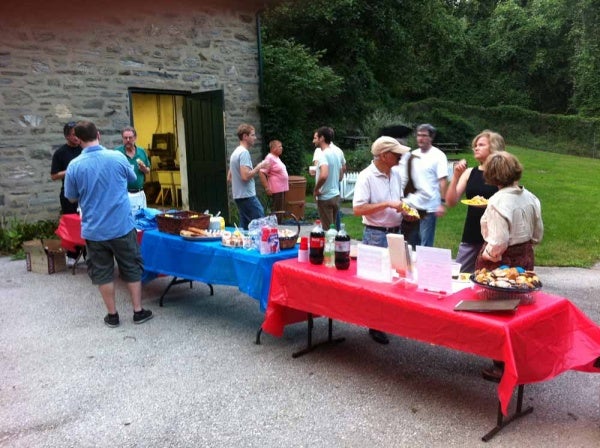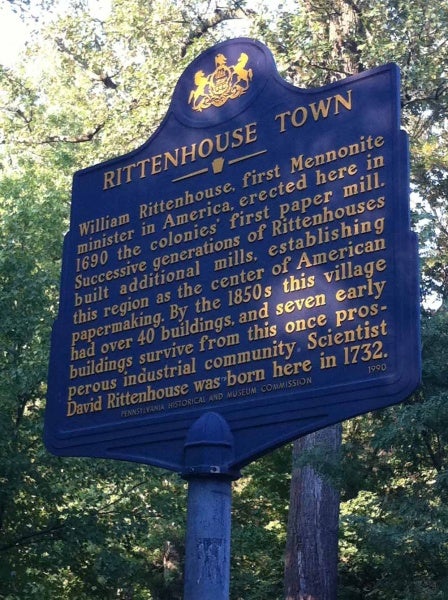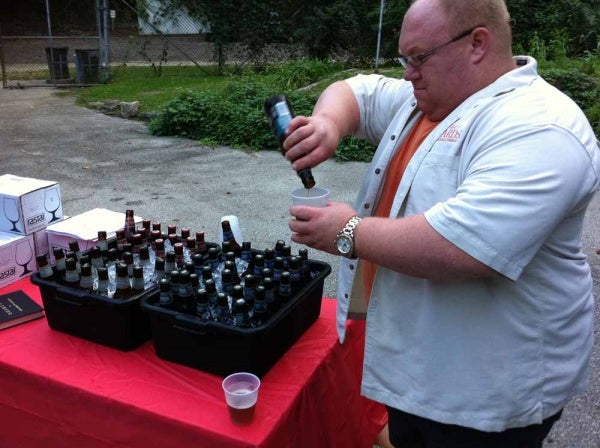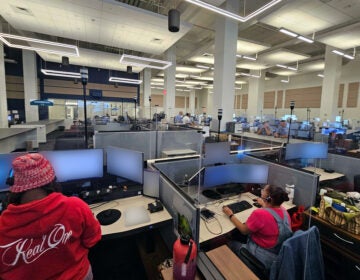Tasting the ‘Ales of a Revolution’ at RittenhouseTown
On Tuesday evening, about 30 people gathered at an idyllic spot along the Wissahickon Creek with the quaint name of RittenhouseTown for “A Revolutionary Happy Hour.” The event was a collaboration of Yards Brewing Company and Historic RittenhouseTown, Inc., the nonprofit organization that maintains the site of America’s first paper mill and the birthplace of one of our nation’s greatest scientists.
The event was meant to showcase Yards’ collection of beers known as “Ales of the Revolution,” as well as raise funds and awareness for the historic property.
Beer, pretzels, and hoagies were served at the property’s barn. Tom Kehoe, president of Yards, was on hand to serve beer to patrons and explain the origins of each of the three brews in the “Ales of the Revolution” series: George Washington’s Tavern Porter, Thomas Jefferson’s Tavern Ale, and Poor Richard’s Tavern Spruce.
Commissioned by famed chef Walter Staib in 1998 for exclusive use at his City Tavern restaurant, the “Ales of the Revolution” were based on recipes developed by Washington, Jefferson, and Franklin, all connoisseurs of fine food and spirit. Ever the bon vivant, Franklin supposedly once declared: “Beer is living proof that God loves us and wants us to be happy.”
But Yards could not use the name “Benjamin Franklin’s Tavern Spruce” because a brewing company in the Good Doctor’s hometown of Boston had already trademarked the Franklin name. They settled on the pseudonym Franklin used as a journalist.
Franklin’s original beer was based on molasses rather than hops or barley, and would be considered too heavy and sweet for modern palettes. Yards tempered the “Poor Richard’s Tavern Spruce” concoction by blending it with a lighter ale of the period.
In 2001, Yards released its “Ales of the Revolution” to the general public. When asked about which beer was his favorite, Kehoe responded, “My favorite is the Washington Porter, but by far the most popular is the Jefferson Ale. Mainly because it’s the lightest in color, and at eight-percent it has the highest alcohol content. Plus, people just like Thomas Jefferson.”
A village laced with history
Rittenhouse Town is a collection of six historic buildings nestled in the Wissahickon Valley, just off of Lincoln Drive in Germantown. It was originally the site of America’s first paper mill, founded by Dutch immigrant William Rittenhouse in 1690. Germantown, established only two years after William Penn founded Philadelphia, quickly became a haven for members of dissident sects fleeing persecution in Germany and Holland, especially the Anabaptists. William Rittenhouse was not only a paper manufacturer, but also the first Mennonite minister in the Colonies.
Rittenhouse built his mill complex on the banks of a small Wissahickon tributary now known (fittingly) as Paper Mill Run. Previously, the American colonies had to import all of their paper from Europe, and pent-up demand allowed Rittenhouse’s business to flourish. The semi-feudal complex would eventually grow to 45 buildings, and include water mills, worker housing, a bakery, a foundry, and several stone houses for the Rittenhouse family.
“This place was going great guns in the 18th century,” said Chris Owens, executive director of Historic RittenhouseTown.
David Rittenhouse, science pioneer
The Rittenhouse family moved on to distinguish itself in science as well as industry. William’s great-grandson David Rittenhouse (1732-1796) became America’s foremost scientist of the age. Entirely self-taught, as a child he first tinkered with mill machinery and clocks, and then moved onto mathematics and astronomy. He took it upon himself to build the first telescope ever constructed in the United States, and became the first American to observe the transit of the planet Venus, as well as the first to sight the planet Uranus. By the time of the American Revolution, Rittenhouse had published his papers in scientific journals throughout Europe. An ardent patriot, he was close friends with Benjamin Franklin and Thomas Jefferson. All three were members of the American Philosophical Society, and Jefferson once declared that he would rather attend a dinner with Rittenhouse “than spend a whole week in Paris.”
There is no beer named after David Rittenhouse, but thirty years after his death, the southwestern square of William Penn’s original plan was named in his honor. Today, it is not only one of the city’s most fashionable neighborhoods, but arguably the most successful urban public space in America.
Preserving the historic site
As for the scientist’s family business, the Rittenhouse paper mill continued to operate until 1820, when it was rendered obsolete by more modern facilities. The Fairmount Park Commission acquired the mill complex in 1890, and systematically demolished most of the original structures to create green space and remove industrial structures that had once contaminated the city’s drinking water. The remaining six buildings were used as a cloth factory during the Civil War, then a women’s tuberculosis hospital.
Thankfully, David Rittenhouse’s birthplace, a modest stone house dating from 1707, was spared.
After decades of neglect, Fairmount Park finally leased the property to Historic Rittenhousetown in 1984, whose mission has been to “preserve, restore, and historically interpret” the complex, now designated a National Historic Landmark. The organization has 300 members, and has a full-time staff of two. According to Ariel Wilson, director of education and program development, Historic RittenhouseTown hosts 3,000 schoolchildren annually. They learn how to make paper in the 18th century way (from linen rags, not wood pulp), and take classes in colonial cooking in the original 1732 bakery, which boasts the largest hearth in Philadelphia.
A neighborhood favorite
Although still very much a hidden gem among Philadelphia’s historic sites, the educational programs and culinary events have made RittenhouseTown a favorite destination for residents of Northwest Philadelphia. The organization also hosts the annual Paper Mill Run 5k Race, scheduled this year for Sept. 24.
Mount Airy resident Ed Duffy not only serves on the board, but volunteers as an historical interpreter playing David Rittenhouse.
“Yards has been incredibly nice to us,” Duffy said. “They have regularly donated beer to our fundraising events.”
For his part, chef Walter Staib occasionally comes to RittenhouseTown to prepare 18th century dinners for paying guests using the kitchen equipment David Rittenhouse would have known. “He loves this hearth,” Duffy declared. “It’s so large that he cooks with twelve small fires rather than one large one.”
Today, RittenhouseTown is a reminder of an age when the Wissahickon Valley was one of America’s first industrial hubs, as well as a testament to the enterprise and ingenuity of one of the colonial Philadelphia’s most accomplished families.
WHYY is your source for fact-based, in-depth journalism and information. As a nonprofit organization, we rely on financial support from readers like you. Please give today.


















